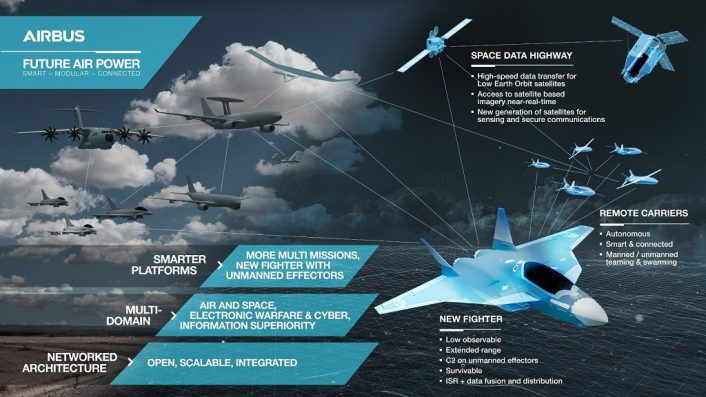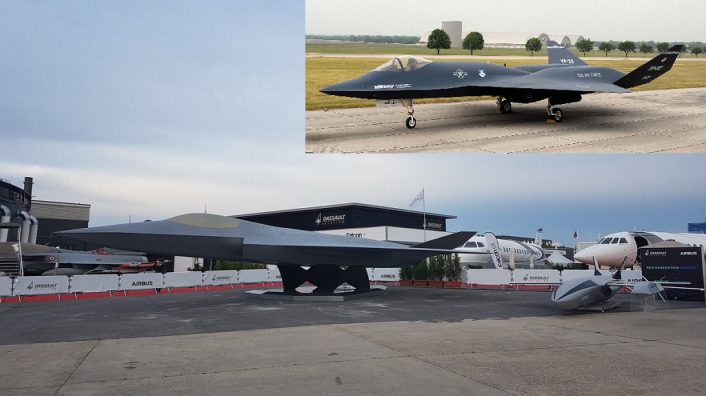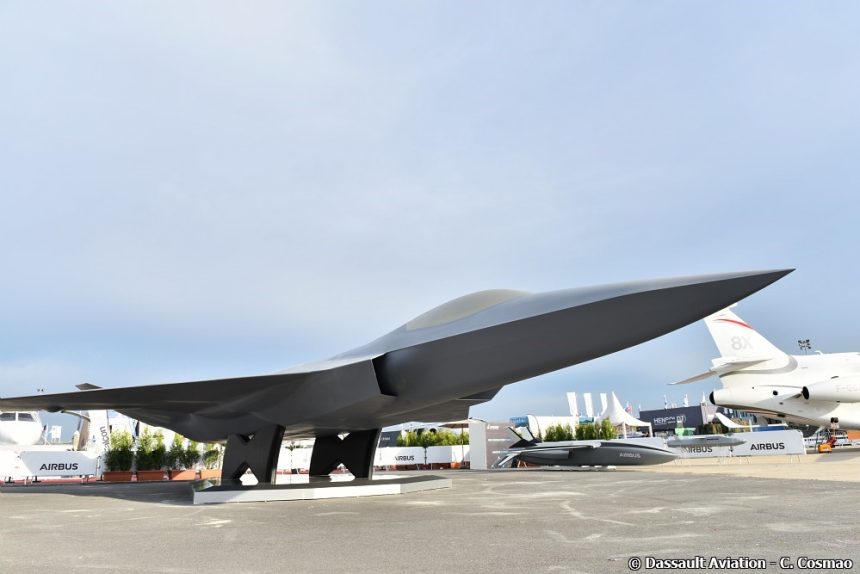The new aircraft will integrate and then replace the current Rafale and Eurofighter fleets starting from 2040.
On June 17, 2019, during the Paris Air Show 2019, Dassault unveiled the first mockup of the Franco-German Future Combat Air System (FCAS)/ Système de Combat Aérien Futur (SCAF), the 6th generation stealth fighter aircraft designed to replace Rafale and Eurofighter. During the same ceremony, the Spanish Defence Minister signed an agreement with which Spain joins the program as partner nation, welcomed by the Defence Ministers of France and Germany and the French President.
Sleek shape of Franco-German NGF mockup from another angle. #PAS19 #avgeek pic.twitter.com/q2gKLLls9k
— Tim Robinson (@RAeSTimR) June 17, 2019
The new aircraft seems to be following the same network-enabled philosophy of the F-35, based on sensor fusion and data sharing, as stated by Airbus: “FCAS is more than a combat aircraft. FCAS is a system of systems consolidating a large array of interconnected and interoperable elements: a new generation fighter aircraft, unmanned MALE drones (medium-altitude, long endurance), the current aircraft fleet (which will still be in service after 2040), cruise missiles and drone swarms. The entire system will be connected and operable with a vast perimeter of mission aircrafts, satellites, NATO systems as well as land and naval combat systems. The new generation fighter aircraft will complete and eventually replace the current Rafale and Eurofighters from 2040 onwards.”

According to this, the FCAS program, first announced during the 2018 ILA Berlin Air Show, is a wider system of which the mockup showed at Paris Air Show represents the main element called Next Generation Fighter (NGF). This aircraft will be combined with unmanned “wingmen” in what’s called the Next Generation Weapon System (NGWS) and all other air assets in the future operational battlespace. In the last few years, many defence experts argued about the 5th generation being the last manned aircraft generation but, as already seen with the BAE Systems Tempest unveiled last year during Farnborough Air Show, the 6th generation still mainly sees a human pilot in the cockpit while considering optionally manned configurations for the future.
Major General Jean-Pascal Breton, program lead FCAS, asked by Jane’s Defence in a 2018 interview about the choice of a manned platform, said: “Our first priorities for the future fighter are air superiority and deterrence, and these are the drivers for a manned aircraft at the core of the FCAS system-of-systems. On the question of a manned or an unmanned aircraft, we have determined that due to our missions we need something that is very close to a conventional combat aircraft. Even if you think artificial intelligence [AI] is performing or not, we trust that in the future there will still be manned aircraft and so this will be the core of the system-of-systems – it will be survivable, supersonic, and maneuverable.”
A possible taster of how a #SCAF #FCAS cockpit might look…expect lots more news from this project at #PAS2019 including options for so-called remote carriers and new weapons. pic.twitter.com/lXq6JYqRkF
— Tony Osborne (@Rotorfocus) June 16, 2019
The reveal of the mockup marks the beginning of the first Demonstrator Phase of the FCAS program, a two-year study based on the 2018 agreement that will last until mid-2021 and worth € 65 million ($ 74 million). This joint study will serve as starting point for technology development for the New Generation Fighter (NGF), Remote Carriers (RC) and an Air Combat Cloud (ACC) prototypes to fly by 2026. The system will be built by Dassault Aviation and Airbus, with Dassault as prime contractor for NGF and Airbus as prime contractor for RC and ACC. Other reported industry partners are Thales and MBDA, with the latter working on a range of weapons and small remote carriers for the aircraft.
Safran (France) and MTU Aero Engines (Germany) are developing an engine for NGF, with MTU focusing on the low- and high-pressure compressors and low-pressure turbine and Safran focusing on combustor, high-pressure turbine and afterburner. During the Air Show Safran reportedly displayed an engine model showing a thrust-vectoring design. According to infographics and the mockup itself, the NGF will be a twin-engined aircraft, with each engine rated up to 30000 lb of thrust.

The Next Generation Fighter mockup’s shape resemble the Northrop YF-23 (the second finalist in the Advanced Tactical Fighter competition which resulted in the F-22) with a slightly more canted tail. The mockup is not very detailed, so it isn’t possible to say if it will be an all-moving tail or a traditional one.
Continuing the comparison with the YF-23, the NGF’s engine nacelles and cockpit appear to be more streamlined. The mockup also sports diverterless supersonic inlets (DSI), similar in shape to those used on the F-35, to ensure high-quality airflow to the engines over a wide range of conditions and reduce the risk of radar waves being reflected when hitting the fan. Like the aircrafts that it’s going to replace, Rafale and Eurofighter, the new fighter uses a delta wing.
Nothing can be said about weapon bays or sensors, since the lower fuselage of the mockup is completely flat. We can assume, however, that the main landing gear will be housed in the wing root, considering the bulge that can be seen in that area similarly to the F-35’s landing gear housing.
The official dimensions are not yet known, but according to Aviation Week Bureau Chief Tony Osborne it should be 1/3rd or 1/4 bigger than a Rafale, with a Maximum Take Off Weight (MTOW) similar to the Mirage IV developed in the ‘50s.









